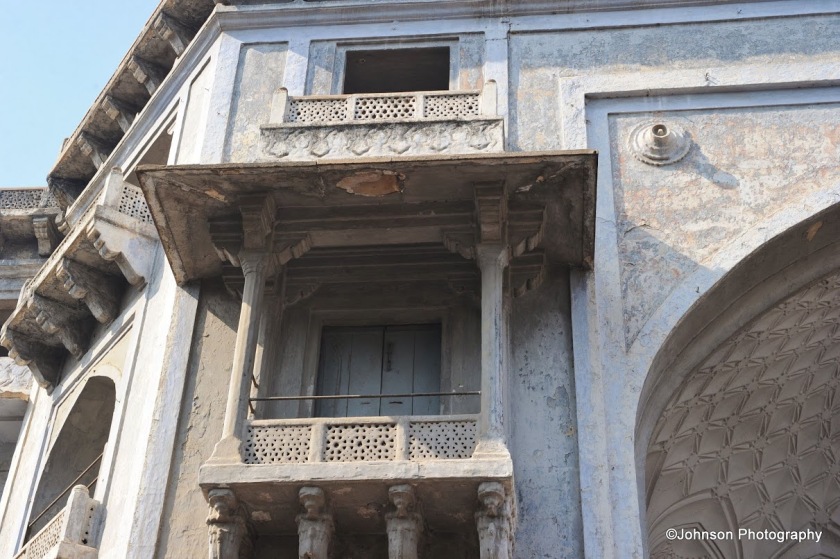Ahmedabad, also known as Amdavad in Gujarati, is the largest city and former capital of the Indian state of Gujarat. Perched on the banks of Sabarmati River, this remarkably cosmopolitan city is rich with Muslim history and many architectural monuments. The area around Ahmedabad has been inhabited since the 11th century when it was known as Ashaval or Ashapalli. The city was founded in 1411 by Ahmed Shah, at the spot where he saw a hare chasing a dog (he was impressed by its bravery). He established Ahmedabad as the new capital of his Sultanate and built Bhadra Fort on the east bank of Sabarmati River. Square in form, enclosing an area of about forty three acres and containing 162 houses, the Bhadra fort had eight gates. The second fortification was built later by Mahmud Begada, the grandson of Ahmed Shah, with an outer wall 10km in circumference and consisting of 12 gates, 189 bastions and over 6,000 battlements. Almost 60 governors ruled Gujarat during the Mughal period including the future Mughal emperors Jagangir, Shah Jahan and Aurangzeb.
In 1732 the Maratha army under Umabaisaheb Khanderao Dabhade, the only female commander- in- chief in the history of Marathas captured the fort from Mughal Sardar Joravar Khan Babi. Ahmedabad was conquered by the British in 1817 and the fort complex was used as a jail by the British.
Bhadra fort housed the royal palaces and the beautiful Nagina Baugh and the royal Ahmed Shah’s Mosque on the west side and an open area known as Maidan-Shahi on the east side. The fort complex was used as a royal court during his reign. On the eastern side of the fort, there is a triple gateway known as Teen Darwaza which was formerly the entrance to the royal square. The road beyond this gate leads to Manek Chowk, a mercantile square.
The citadel’s architecture is Indo-Sarcenic with intricately carved arches and balconies. There are Islamic inscriptions on the arches of the Fort. The palace contains royal suites, the imperial court, halls and a prison. A palace was also built during the time of Mughal governor Azam Khan known as Azam Khan Sarai in 1637. It was used as resting place for travelers in the Mughal era and a jail during British rule. There was a gibbet on the roof of this building used for hanging during the Gujarat sultanate and the British era. It was here that Ahmed Shah hanged his son-in-law who was convicted of murder.












A room in the north wing of Azam Khan Sarai was turned into a temple of Bhadra Kali during Maratha rule. The legend is that years ago Laxmi, the goddess of wealth, came to the gate of Bhadra Fort to leave the city in the night. Watchman Siddique Kotwal stopped her and identified her. He asked her not to leave the fort until he obtained permission from the king. He beheaded himself in order to keep goddess Laxmi in the city. Another version is that he was beheaded by the Sultan in order to prevent the goddess from leaving the city. It resulted in the prosperity of the city. There is a tomb near Bhadra gate dedicated to Siddique Kotwal and a temple to Bhadra Kali, representing Laxmi. A lamp in one of the holes in Teen Darwaza is lit continuously for more than six hundred years by a Muslim family and is dedicated to Laxmi.








When Mahmud Begada expanded and fortified the city there were eighteen darwazas or gates to the city, fifteen large gates and three small ones. Of the fifteen gates, one was closed and three were added later. Each of these gates had beautiful carvings, calligraphy and some of them even balconies. Each of these entrances to the city has unique names like Delhi Gate, Sarangpur Gate, Raipur Gate etc. The area surrounding these gates has adopted the name of the gate as the name of the locality. There were two gates constructed during the British time, after opening of railways connecting Bombay in 1864 to facilitate the movement of public. They are known as Prem Darwaja and Panchkuva gate. Panchkuva gate was built in 1871 for easy access to the railway station. This gate consists three pointed arches, the central one 18 feet wide and 28 feet high and each side gateway measuring 7 feet wide and 19 feet high.



Informative post:)
LikeLike
Thanks.
LikeLike
Thank you for the narrative and the pictures. I felt as though I was walking with you and you were my terrific tour guide.
LikeLike
Thank you very much and glad that you enjoyed the post.
LikeLiked by 1 person
It is so well preserved! History is being lived there every day now. Just as it was before!
LikeLike
There is an active heritage conservation group in that city which take keen interest in conserving heritage. More such details will be included in the next few posts.
LikeLiked by 1 person
Very interesting post a gorgeous photos
LikeLike
Great shots of the market hustle.
LikeLike
Thanks, Brennen for your visit and the comments.
LikeLike
i’m happy to have
experienced these vivid images & informative verse 🙂
LikeLike
Thank you very much
LikeLike